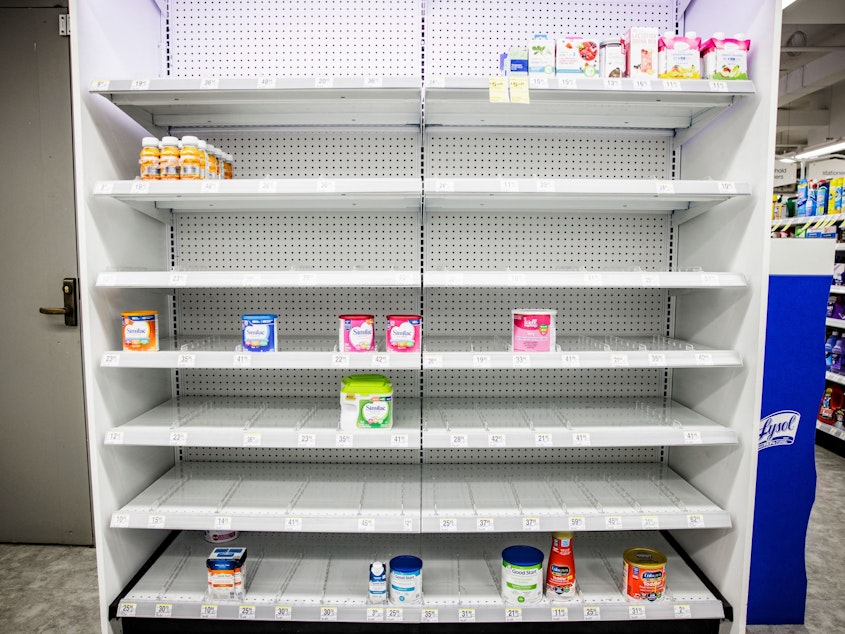As the baby formula crisis worsens, it's also magnifying disparities in the U.S.

The mothers Tess Frear works with were already struggling. Most of them are single parents, typically from economically disadvantaged families. Sometimes they're escaping domestic violence; sometimes they're as young as 15.
For these new mothers, it was hard enough just trying to get basics such as diapers or clothing. Then came the baby formula shortage.
"There's definitely desperation," said Frear, executive director of the baby supply bank Helping Mamas in Knoxville, Tenn. "These mamas are just scared, you know. What are they going to do?"
More than three months since Abbott Nutrition issued a voluntary recall of powder formula manufactured at a Michigan production plant, further stressing pandemic-related strains in the supply chain, that desperation has become more acute. One month ago, the average out-of-stock rate nationwide was about 40%, according to the retail analytics company Datasembly. For the week ending May 28, that rate had surged to 73.6%.
The frustration is being felt practically everywhere. This time last year, the average out-of-stock rate in the U.S. hovered around 6%. Store shelves were practically full all of the time. By the end of the last full week in May, not a single state was below 45%, according to Datasembly. In states such as Arizona, California, Georgia and Mississippi, the rate was creeping toward 95%. Everywhere you look, shelves are nearly bare.
Sponsored
For some, the crisis has been particularly painful. Even though most families will give formula to an infant at some point during their first year, parents from low-income households or from communities of color often depend on it the most.
For some, searching for formula has become a job
The majority of all formula sold in the U.S. is purchased through a federally funded food assistance initiative known as the Special Supplemental Nutrition Program for Women, Infants and Children, or WIC. Somewhere between 50% and 65% of all formula is purchased by WIC families, according to the National WIC Association. That's enough formula, the group says, to feed an estimated 1.2 million infants.
"This crisis, which is truly a manufacturing sector failure, has impacted all parents of formula-fed infants, but it magnifies the disparities that have long existed," according to Brian Dittmeier, senior director of public policy at the National WIC Association. "Searching for formula has to an extent become a full-time job, and low-income families that are working two jobs already may not have the bandwidth to fully invest in the search," he said.
Similarly, the shortage has underscored what are sometimes deep disparities in breastfeeding rates when broken down by race. The American Academy of Pediatrics recommends that infants be exclusively breastfed for about the first six months, with continued breastfeeding while introducing complementary foods for at least 12 months. And while more than 90% of Asian American mothers and 85% of mothers who are white breastfeed their newborns, for Black mothers, the rate is just under 74%, according to data from the Centers for Disease Control and Prevention.
Sponsored
In some places, the rates are far lower. In both Arkansas and Mississippi, for example, less than 53% of mothers who are Black breastfed their babies at birth, according to the CDC.
There are myriad reasons why mothers rely on formula. Some, for example, turn to it after facing issues with lactation or latching. Others might need it because an illness with the mother or the baby makes nursing impossible.
But experts say the ongoing formula shortage also highlights key structural barriers that keep millions of women from breastfeeding. For example, just 51% of employers make it easy for new moms to breastfeed by providing an on-site lactation room, according to the CDC.
Other parents might lack paid family leave at their jobs — once back at work, many breastfeed at lower rates than those with more generous leave policies. One study published last year in the journal Health Equity found 33% of Black women and 25% of Hispanic women received no pay while on leave. For white and Asian American women, the rates were 10% and 13% respectively.
"People are saying, 'Why don't they breastfeed?' Well, maybe they can't breastfeed at their job or maybe there is some other circumstance where they cannot breastfeed. There's just a variety of reasons why people cannot," said Frear.
Sponsored
The U.S. is importing formula to ease the shortage
Last month, the Biden administration invoked the Defense Production Act to speed up domestic production of infant formula. The White House has also worked to import tens of millions of additional bottles of formula from overseas, with more expected to arrive in the coming days. The Abbott plant at the center of the recall is expected to reopen for production in the coming days, but even once the plant resumes operation, it could take another six to eight weeks before formula from the plant is available on grocery shelves.
Until then, Frear said she and her network will keep working as best they can to help as many parents as they can get the formula that they need. But it's hard work. There are many different kinds of formula on the market, and many of the children they serve have health issues that require a specific type of product.
Sometimes the organization can track it down from one of their followers on Facebook or Instagram. When they can't, they'll help pair a new mother with a pediatrician or nutritionist to try to figure out a temporary alternative.
"We just take it one day at a time," said Frear. "Each day we keep on moving forward and try to help these families be the best that they can be." [Copyright 2022 NPR]


